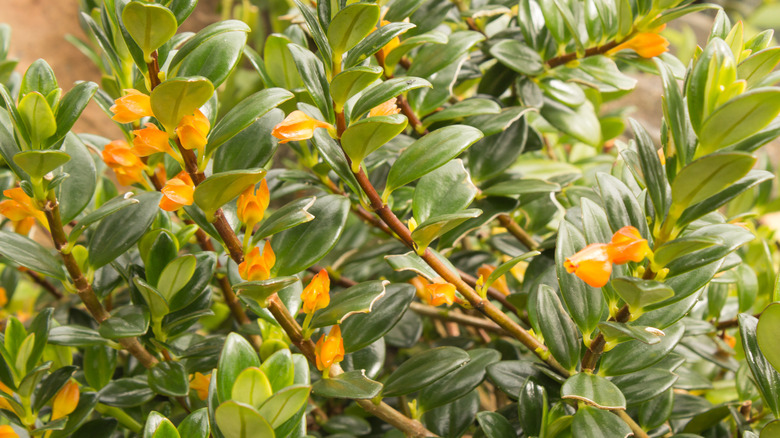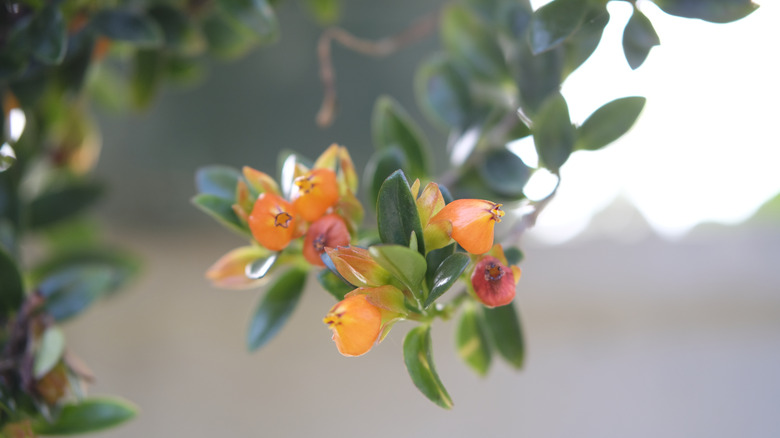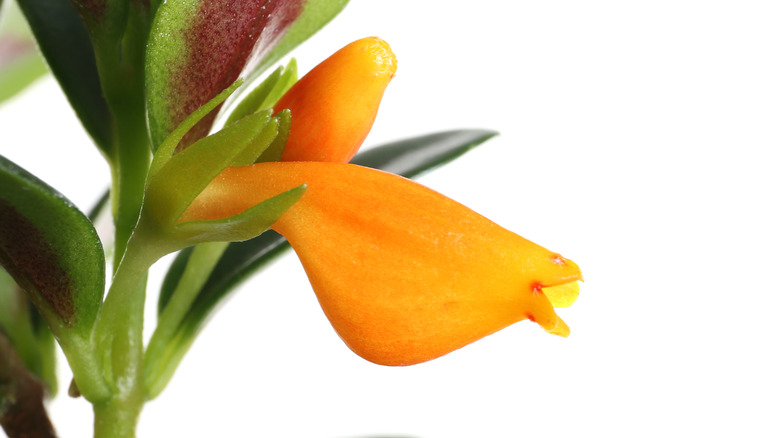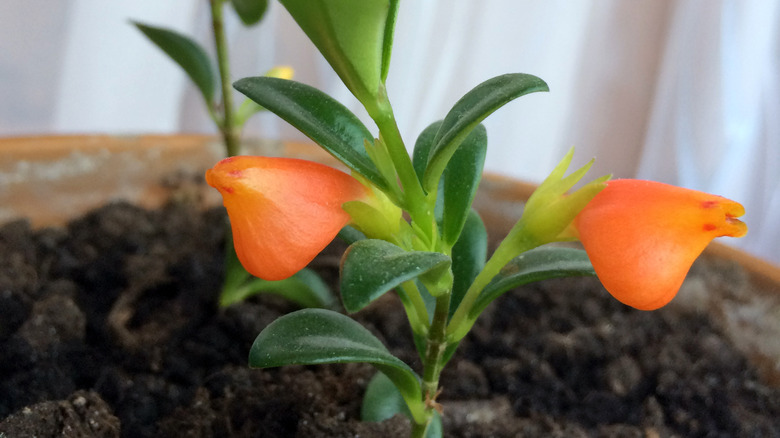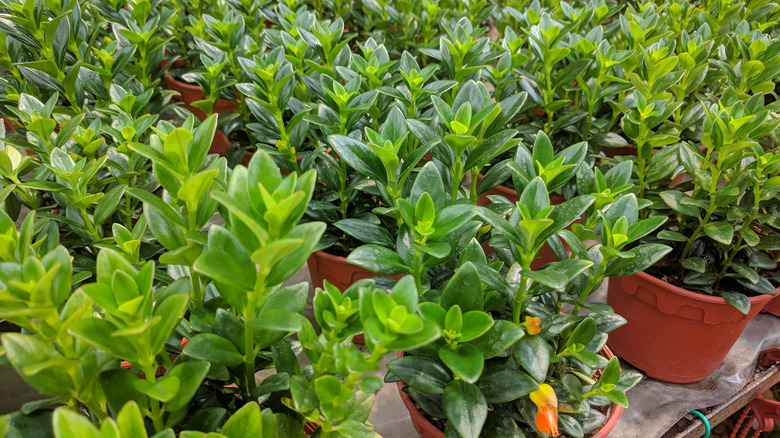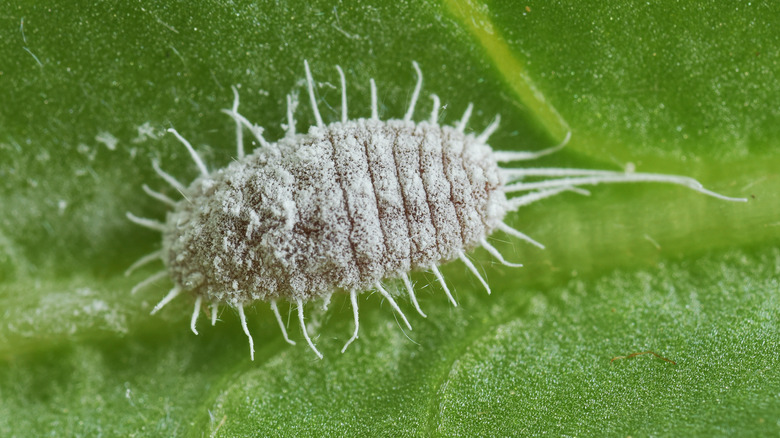How To Care For A Goldfish Plant
Nematanthus gregarius, also known as the goldfish plant, is a perennial subshrub native to the equatorial climate of Central and South America. According to My Domaine, this plant gets its common name from its orange and red goldfish-shaped flowers. They bloom in the spring for up to 20 days, producing over 100 flowers if the plant is large enough, as per Raya Garden. The goldfish plant is a great houseplant as it doesn't need direct sunlight or frequent watering. Yet, some gardeners warn that it is not beginner-friendly because it requires daily attention.
Besides its unique flowers, Nematanthus gregarius can also be identified by its branches that grow up to 3 feet long, which also feature small, waxy, dark green leaves all over. In adulthood, the goldfish plant will appear bushy unless you decide to keep it well-pruned. If you've been looking for a way to liven up your plant collection, buying a goldfish plant is a great way to do just that.
How to use goldfish plant in garden
Even though the goldfish plant is most often grown indoors, you may be able to implement it into your garden if you live in the right environment. The first thing you'll want to do before planting is to check your USDA hardiness zone. These plants can only survive in zones 10 and 11, as per The Spruce. However, if you live in the slightly colder 8 and 9 zones, you can choose to keep this plant outside in a pot during the summer and move it inside during the winter.
Keep in mind that the goldfish plant should not be planted in full sunlight. Choose a shady spot in your yard where this plant can receive bright, indirect sunlight. Consider planting yours under the shade of a large tree or bush. Some gardeners place the goldfish plant in a hanging basket on their porch. This makes it easy to move inside and allows it to get the shade it needs. Martha Stewart reminds us that outdoor goldfish plants need even more attention than their indoor counterparts. Know that you will likely have to water this plant daily to meet its water and humidity requirements.
How to grow goldfish plant
Before you can grow a goldfish plant, you will need a self-draining container and a loose, well-draining potting mix. Once you've gathered your materials, you can choose to propagate this plant through stem cuttings or division or you can simply buy it as a young plant from your local nursery. If you know someone willing to share their plant with you, propagation is not difficult.
To propagate a goldfish plant through stem cuttings, you can start by snipping off a 3-inch piece of stem with sterile scissors. Make sure that this stem is free of flower buds, says The Spruce, which could make it more difficult for the cutting to grow healthy roots. After this, you can dip the cut end of the stem into a rooting hormone to accelerate growth, though this step isn't necessary. Place your cutting in a glass of water, refresh it daily, and wait for the roots to grow. When it has developed roots, you may transplant it into moist soil in a pot.
Alternatively, you can grow a goldfish plant through division. Raya Garden recommends carrying out this task in the spring to coincide with yearly repotting. After removing your goldfish plant from its container, tease as much of the soil from its roots as possible. Then, carefully separate the stems, making sure each section has a healthy root ball to continue growing. Repot the sections as normal.
How to care for goldfish plants
Growing a goldfish plant is certainly not for beginner gardeners, yet with enough time and research, we know you can nurture this unique beauty into adulthood. Before purchasing this plant, you should be prepared for the amount of attention it needs. Nematanthus gregarius can only grow in humid weather that consistently stays above 60 degrees Fahrenheit, says Guide to Houseplants. You will likely need to mist your goldfish plant on a daily basis to keep up with its humidity requirements. However, it won't need to be watered as often. In the summer, make sure the soil is always damp, but not soggy. Excess water can lead to root rot and similar problems. During the winter, you can ease up, letting the top inch of soil dry out between waterings.
Goldfish plants appreciate being placed close to a window that doesn't receive direct light, as per My Domaine. They are sensitive to sunlight and can be prone to scorched leaves when left in bright windows. Additionally, goldfish plants benefit from light fertilization during the growing season. Feeding your plant every couple of weeks with a diluted fertilizer can accelerate flower, leaf, and branch growth.
How to repot a goldfish plant
Luckily, you won't need any special tools or skills to repot your goldfish plant. It only takes a new pot and some well-draining potting soil to get started. As explained by SFGate, this plant does not mind being pot-bound, and it can go quite some time between repottings. However, if you notice roots coming out of its drainage holes, it's probably best to repot sooner rather than later.
To repot, you can gently take your goldfish plant out of its pot, soil and all. Do this in the early spring for the best results. Then, gently comb the excess dirt out, taking care not to damage the roots. You can use your fingers or a gardening fork. Place your plant into its new pot, which should be a couple of inches wider in diameter than the last. Pack the new soil around and on top of your goldfish plant's roots. Water it generously until water runs out of the drainage holes. Finally, place it in a window with plenty of indirect sunlight.
Goldfish plant common pests and problems
Like many houseplants, the goldfish plant's most common pests and problems include mealybugs, aphids, and root rot. Each of these issues can be easily dealt with and are rarely fatal unless they are left to worsen for long periods of time. Mealybugs and aphids are very similar creatures. They both suck the sap from your plant, causing it to wither and become more susceptible to disease. To kill these oval-shaped menaces, you can simply spray your plant with diluted rubbing alcohol or soapy water, as per Joy Us Garden. For persistent mealybugs and aphids, you may need to rub them off with a cotton ball soaked in one of the abovementioned solutions.
Root rot is easier to deal with. It can even be entirely avoided by properly watering your plant, explains Wild Interiors. Do your best to stick to an adequate watering schedule and always throw out excess water sitting in your goldfish plant's saucer. To identify root rot, gently remove your plant from its container and look for mushy brown roots. If you find some, cut them off with sterile scissors and repot as normal. With a healthy watering schedule, your goldfish plant should return to its original shape and color.
